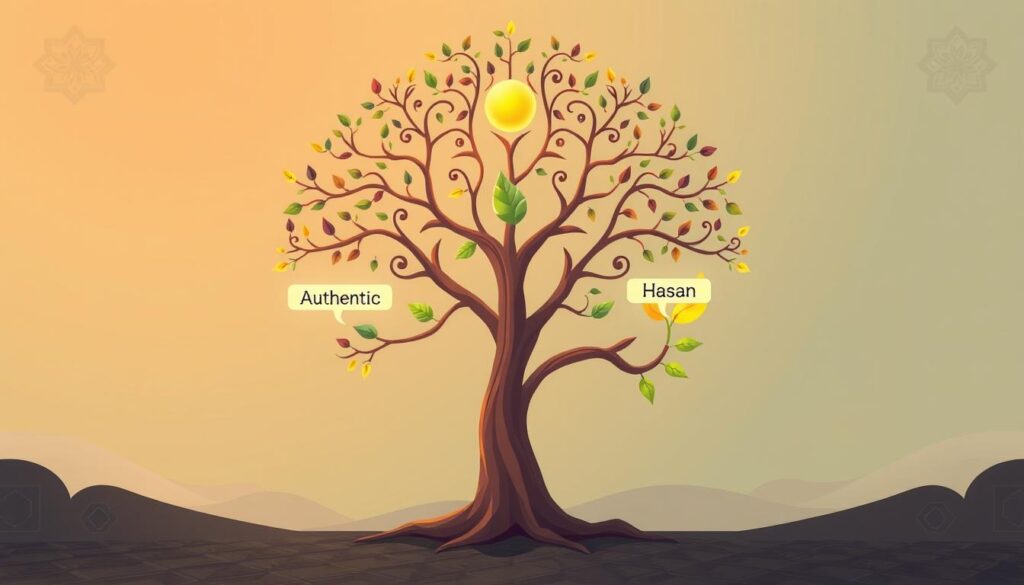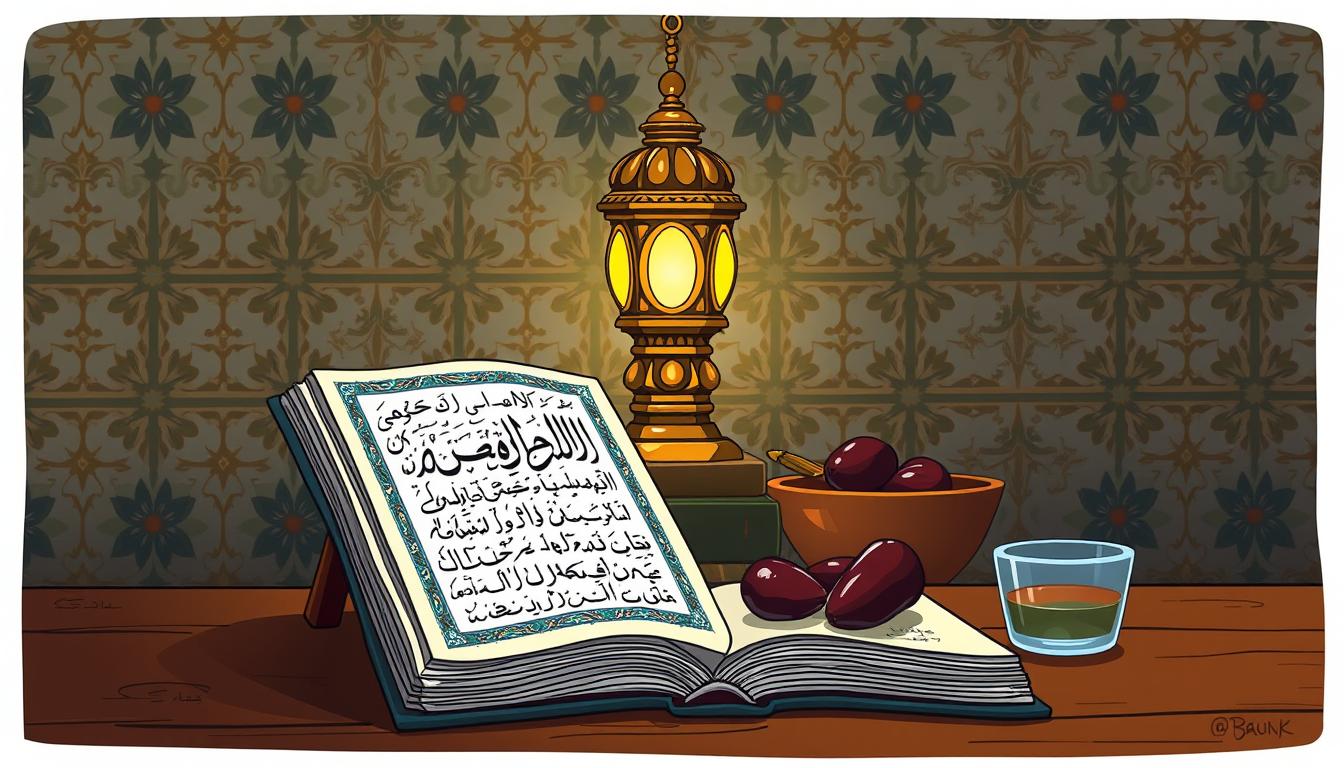The Hadith corpus has hundreds of thousands of reports. It’s the second most important source for law, ritual, and creed after the Qur’an. We aim to provide a guide to common Hadith terms. This will help Muslims understand and apply Islamic principles in their daily lives.
Our goal is to simplify Islamic terminology. We want to empower Muslims to deepen their knowledge and connection with their faith. We also want to explore the significance of Hadith glossary and Hadith terminology in Islamic studies.
We will explore the meanings and significance of various terms. This includes Common Hadith Terms. We aim to help Muslims navigate the complexities of Hadith terminology and appreciate the importance of Hadith glossary in Islamic scholarship.
By understanding these terms, we can gain a deeper appreciation for Islamic thought and practice. We can develop a stronger connection to our faith through the study of Hadith terminology.
Key Takeaways
- Hadith terminology is a key part of Islamic studies, with hundreds of thousands of reports in the Hadith corpus.
- Understanding Common Hadith Terms is essential for appreciating the significance of Hadith in Islam and navigating the complexities of Hadith glossary.
- Hadith terminology includes various classifications, such as Mutawatir and Ahad. These are essential for assessing the authenticity of narrations and understanding the importance of Hadith terminology.
- The study of Hadith terminology can deepen our knowledge and connection with our faith. It provides a stronger understanding of Islamic principles and practices, including the significance of Hadith glossary.
- By simplifying Islamic terminology, we can empower Muslims to apply Islamic principles in their daily lives. We can develop a greater appreciation for the richness and diversity of Islamic thought and practice, through the study of Common Hadith Terms and Hadith terminology.
What is a Hadith?
Many of us have heard the term Hadith but might not know its meaning. Simply put, a Hadith is the sayings, actions, and approvals of Prophet Muhammad. These are seen as a key source of Islamic law and tradition. The Hadith definitions offer insights into the Prophet’s life and teachings, making them vital in Islamic studies.
The Islamic Hadith is a collection of stories passed down through generations. It is a key guide for Muslims. The Prophet’s sayings glossary is a detailed collection of these stories. It helps us understand the Prophet’s teachings and message better.
There are different types of Hadith, like Sahih, Da’if, and Hasan. Each has its own level of trustworthiness. Knowing about the Hadith definitions and types helps Muslims see the importance of these traditions in their lives.
Studying Hadith is a big and complex area. Many scholars and researchers work on it. By looking into the Islamic Hadith and Prophet’s sayings glossary, we can understand the Prophet’s teachings better. We can then apply them to our lives in a meaningful way.
Key Terminology in Hadith Studies
We aim to give readers a deep understanding of key terms in Hadith studies. This includes Hadith vocabulary, Essential Hadith words, and Important Hadith expressions. Knowing these terms is key to judging the authenticity and reliability of Hadith.
A reliable Hadith is one that is seen as authentic and trustworthy. The terms Sahih, Da’if, and Hasan describe a Hadith’s authenticity and reliability. A Sahih Hadith is seen as authentic and reliable, while a Da’if Hadith is weak or unreliable.
Here are some key terms to understand:
- Sahih: A Hadith that is considered authentic and reliable.
- Da’if: A Hadith that is considered weak or unreliable.
- Hasan: A Hadith that is considered good, but not as strong as a Sahih Hadith.

By grasping these key terms and Hadith vocabulary, we can better appreciate the complexity of Hadith studies. This helps us make informed choices about which Hadith to follow.
| Term | Definition |
|---|---|
| Sahih | A Hadith that is considered authentic and reliable. |
| Da’if | A Hadith that is considered weak or unreliable. |
| Hasan | A Hadith that is considered good, but not as strong as a Sahih Hadith. |
Understanding the Chain of Narration (Isnad)
We know how vital it is to check if Hadith is real through the chain of narration, or Isnad. This means following the narrators back to the Prophet Muhammad. It makes sure the Hadith is true and trustworthy. The Hadith lexicon and Islamic Hadith definitions help a lot in this task.
They give us a deep understanding of the Prophet’s sayings and their meaning. The Prophet’s sayings glossary is key to grasping the Hadith’s details and how to apply them in life. By looking at the chain of narration, we see the care and strict standards used to confirm Hadith’s truth. This boosts our faith and helps us understand Islamic teachings better.
Important parts of Isnad include:
* Checking if the chain of narrators is complete and continuous
* Judging if the narrators are reliable
* Seeing if the Hadith matches other Islamic teachings
By looking at these points, we make sure the Hadith is correct and reliable. This is important for guiding our actions and choices as Muslims.
Categories of Hadith
We aim to give readers a full understanding of Hadith categories. This is key to knowing if Islamic Hadith definitions are trustworthy. The Prophet’s sayings glossary helps us grasp these categories.
There are many types of Hadith, like Qudsi, Mutawatir, and Ahad. Qudsi Hadith is seen as very sacred and divine. Mutawatir Hadith is widely accepted and true. Ahad Hadith, though, has fewer narrators than Mutawatir.
Types of Hadith
- Qudsi Hadith: considered sacred and divine
- Mutawatir Hadith: considered universally accepted and authentic
- Ahad Hadith: narrated by fewer reporters than Mutawatir Hadith
Knowing about Hadith categories helps us appreciate Islamic tradition more. By learning about Hadith terminology and definitions, we understand the Prophet’s sayings better. This is important for Islamic law and theology.

| Category | Description |
|---|---|
| Qudsi Hadith | Considered sacred and divine |
| Mutawatir Hadith | Considered universally accepted and authentic |
| Ahad Hadith | Narrated by fewer reporters than Mutawatir Hadith |
Role of Companions in Hadith
The Companions of Prophet Muhammad were key in keeping and sharing Hadith. They were the Prophet’s closest followers and helped shape Islamic tradition. Their work in Hadith vocabulary, like Essential Hadith words and Important Hadith expressions, is very important.
Learning about the Companions shows their commitment to the Prophet’s teachings. They memorized and taught the Prophet’s words. To know more about them, visit online resources that share their stories and roles in Hadith.
The Companions’ impact on Hadith can be summed up as follows:
- Preserving and transmitting Hadith: They were vital in keeping Hadith accurate and true.
- Shaping Islamic tradition: Their understanding of Hadith helped form Islamic law and tradition.
- Providing Essential Hadith words and Important Hadith expressions: Their knowledge of Hadith vocabulary is key to understanding Islamic teachings.
Studying the Companions’ role in Hadith helps us understand Islamic tradition better. It shows the importance of Hadith vocabulary, including Essential Hadith words and Important Hadith expressions. This knowledge helps us value Islamic teachings and work to preserve Hadith for future generations.
Major Hadith Collections
We aim to give readers a full grasp of the major Hadith collections. These are key for understanding Islamic Hadith definitions and the Prophet’s sayings glossary. The Hadith lexicon is a vital tool for Muslims to appreciate the richness and diversity of Islamic tradition.
The web source explains that Sahih al-Bukhari and Sahih Muslim are top choices for authentic Hadith collections. These collections are classified as Jaami collections. They cover a wide range of Islamic knowledge areas.
Notable Collections
- Sahih al-Bukhari: has about 7,275 hadith, including repetitions, with around 2,600 unique hadith
- Sahih Muslim: has about 4,000 hadith, making it the second most authentic and widely referred-to Hadith collection
- Sunan Abu Dawood: has approximately 4,800 hadith
By understanding the major Hadith collections, Muslims can appreciate the richness and diversity of Islamic tradition. This enhances their knowledge of Islamic Hadith definitions and the Prophet’s sayings glossary. It enriches their Hadith lexicon.
![]()
Hadith Interpretation (Sharah)
We think it’s key for Muslims to grasp Hadith terminology and Islamic Hadith definitions. Sharah, or the interpretation of Hadith, is vital. It helps us understand the Prophet’s sayings better. By studying Sharah, we get a deeper look into the context and meaning of Hadith.
Importance of Sharah
Sharah is important because it gives clear explanations of Hadith. This makes Hadith easier for more people to understand. It also helps clear up any confusing parts of Hadith, showing its importance in our lives.
How Sharah Enhances Understanding
Sharah makes us understand Hadith better by using a detailed approach. It teaches us about different Hadith types and how they fit into Islamic law. By learning Sharah, we can better grasp the Prophet’s sayings and how they guide us.
| Category | Description |
|---|---|
| Hadith Terminology | Understanding the language and concepts used in Hadith |
| Islamic Hadith Definitions | Defining key terms and concepts in Islamic Hadith |
| Prophet’s Sayings Glossary | A collection of the Prophet’s sayings and their explanations |
Common Misconceptions about Hadith
We often come across misconceptions about Hadith, which can lead to a distorted understanding of Islamic traditions. To address these misconceptions, it’s essential to understand the context and nuances of Hadith vocabulary. This includes Essential Hadith words and Important Hadith expressions. By doing so, we can avoid misinterpretations and overgeneralizations, and develop a more nuanced understanding of Islamic principles.
Misinterpretations
Misinterpretations of Hadith can occur when we fail to consider the historical and cultural context in which they were narrated. For instance, the Qur’an acts as a “mizan” (scale) for interpreting and validating Hadith, highlighting the importance of understanding the relationship between the two. By recognizing the possibility of misinterpretations, we can take steps to avoid them and develop a more accurate understanding of Hadith.
Overgeneralizations
Overgeneralizations can also occur when we fail to consider the diversity of Hadith and the various contexts in which they were narrated. To avoid overgeneralizations, it’s essential to study Hadith in depth, using reliable sources and considering the opinions of reputable scholars. By doing so, we can gain a more nuanced understanding of Hadith and avoid making sweeping statements that may not be supported by the evidence.
By understanding common misconceptions about Hadith and taking steps to avoid them, we can develop a more accurate and nuanced understanding of Islamic traditions. This, in turn, can help us to deepen our faith and live more fulfilling lives, guided by the principles of Hadith vocabulary, Essential Hadith words, and Important Hadith expressions.

Conclusion: The Significance of Hadith Terminology
As we wrap up our look at Hadith terminology, it’s clear that knowing these Islamic Hadith definitions is key. It helps us connect deeper with the Prophet’s teachings. By learning the Prophet’s sayings glossary, we see the rich variety and depth in Hadith tradition.
The Hadith, filled with the Prophet Muhammad’s words, actions, and silent nods, is essential. It guides Muslims in their everyday lives and spiritual paths. Learning Hadith terminology helps us understand these teachings better. It strengthens our faith and shows deep respect for Islamic tradition.
We urge all readers to keep exploring the Hadith’s vast knowledge. Whether through study, research, or reflection, diving into Hadith terminology enriches our connection with the Prophet’s teachings. Let’s start this journey of knowledge, using ancient wisdom to light our way to a brighter future.






